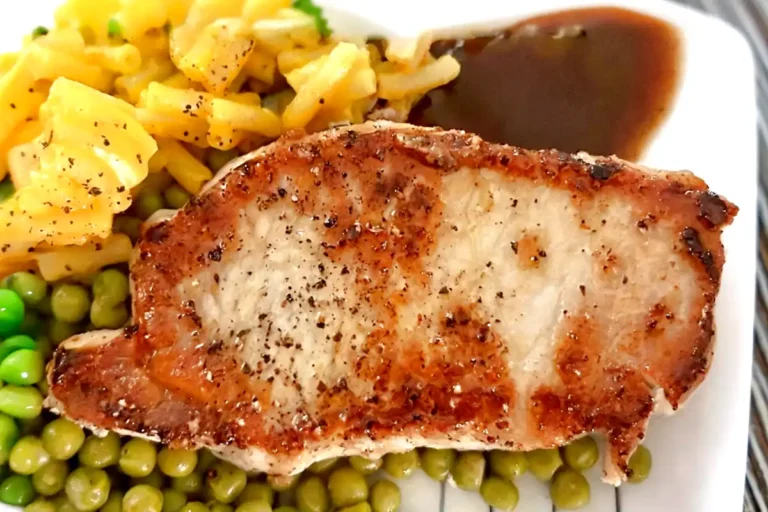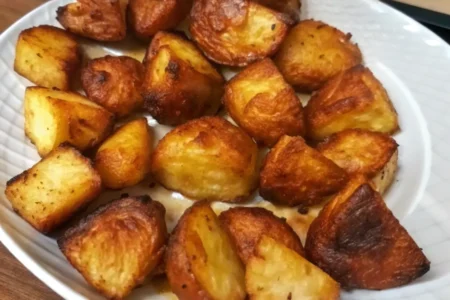The first time I cooked a pork chop that didn’t taste like the sole of a boot, I actually gasped. It had juice. Real juice. I cut into it expecting sawdust, and instead got a blush of pink and a little waterfall of flavor. It was buttery, garlicky, and somehow… elegant. And no, it wasn’t dumb luck. It was technique. Old-school, honest cooking with just the right heat and a few chef-y secrets.
Let’s face it, pork chops have trust issues. Most of us grew up thinking they belonged on the dry-and-chewy shelf alongside beef jerky. But a good pork chop? Oh, it deserves a seat next to a fine steak. We’re going full-on pork perfection today, and it starts with the right cut, the right sear, and the most soul-warming pan sauce this side of Sunday supper.
Why Everyone Thinks Pork Chops Are Boring (They’re Not)
There’s a reason pork chops get a bad rap. They’re often thin, overcooked, and completely stripped of flavor. The problem usually starts in the grocery aisle. Grab a thin, boneless chop and you’re asking for trouble. Go thick or go home. Bone-in, center-cut, fat cap still intact—that’s where the magic begins.
As one chef put it, “Moisture is the enemy of a good sear.” And he’s right. A dry pork chop before the pan means a juicy one after.
The Secret to That Golden Restaurant Crust
Picture this: a hot pan, the sizzle of oil, and the chop landing fat-side down like it owns the skillet. That’s when you know you’re doing it right.
Here’s the trick: don’t crowd the pan. A couple of thick chops need space to breathe and brown. Too many and they steam. Let your pork caramelize on one side—don’t flip it constantly. When the bottom looks like toasted caramel, then you flip. Only then.
Once both sides are browned, hold that baby upright on its fat side and let it render out—think pork candle. It melts, crisps, and tastes like heaven. Then? Butter. Garlic. Thyme. Baste, baste, baste. That’s when you know dinner is about to get serious.
Let’s Talk Temperature (Yes, You Need a Thermometer)
Forget cutting into it “just to check.” That’s how you lose your juiciness. Use an instant-read thermometer. Stick it near the bone—135°F is your golden number. It’ll rise a few degrees as it rests.
And rest it must. At least 5–7 minutes. Why? Because if you slice too early, those glorious juices run away. Let them redistribute. Be patient. It’s worth it.
Making the Creamy Pan Sauce: No Roux, No Fuss
Now that the pork is off resting in peace, it’s pan sauce time. First, ditch the old butter and oil—but keep those crusty brown bits at the bottom. That’s called fond, and it’s flavor gold.
Start with a bit of oil, shallots, and garlic. Let them sizzle gently. Add thyme, and if you’re feeling fancy, a splash of apple brandy. No brandy? Cider, white wine, or even beer work great. That sizzle you hear? That’s deglazing—pulling all those stuck-on flavors back into the mix.
Next comes the mustard—whole grain, please—and then the heavy cream. Don’t be shy. If it gets too thick, a splash of chicken broth will loosen it up. Let it bubble and reduce. When you can drag a spoon through it and leave a clean line, it’s done.
Finish it with a knob of butter and a handful of parsley for brightness. Spoon it around (not over) your chop. You didn’t spend all that time browning just to smother it.
3 Mistakes to Avoid with Pork Chops
1. Buying thin chops
They cook too fast and dry out before you can blink.
2. Skipping the thermometer
No one wants to guess when $12 worth of meat is ready.
3. Skimping on the rest
Cut too soon and you’ll lose all the good stuff to the cutting board.
5 Ways to Serve This Pork Chop
| Serving Style | Description |
|---|---|
| Classic Plate | With mashed potatoes and green beans |
| Rustic French | With lentils and Dijon mustard glaze |
| Italian-Inspired | Over creamy polenta with gremolata |
| Sunday Supper Style | With roasted apples and onions |
| Southern Comfort | With cheesy grits and sautéed greens |
Creative Twists and Flavor Bombs
Want to shake things up? Try marinating the pork in olive oil, rosemary, sage, and garlic for a few hours before cooking. Or go bold with a Korean-style glaze using gochujang and soy.
Feeling fruity? Throw in a few apple or pear slices while the pork sears. Let them soften and caramelize in the pan fat—they’ll soak up every savory drop.
Some cooks crisp up the pork skin separately, turning it into a crunchy garnish. One chef even calls it “a bar snack that earned a seat at dinner.” Amen to that.
Pork and Sauce: A Love Story
There’s something so satisfying about dragging a bite of pork through a creamy, tangy, mustard-laced sauce. It’s got layers: the richness of butter, the brightness of brandy or cider, the nubbly texture of grainy mustard.
And don’t forget that pork fat. Oh, that pork fat. It crackles and melts and makes everything better.
Cultural Notes: Pork Around the World
Pork chops might be a weeknight staple in the U.S., but they’re part of a global story.
- Germany: Schnitzel-style, breaded and fried.
- Japan: Tonkatsu—panko-crusted and served with shredded cabbage.
- Italy: Brined and grilled, often with fennel or lemon zest.
- China: Red-cooked, braised in soy, ginger, and sugar.
- Mexico: Chuletas a la Mexicana, stewed with tomato, onions, and chili.
Each version tells a story. This one just happens to include a pan sauce you’ll want to spoon onto everything, including your own fingers.
A Chef’s Quote Worth Framing
“Cooking is a lot about technique and the process of cooking, but at the end of the day, you’ve got to put some love in it.” — Chef Frank Proto
He’s right. The sauce, the sear, the little touches—they matter. But what really transforms pork chops from boring to brilliant? Love. That, and a whole lot of butter.
The Final Forkful
So there it is. The pork chop that makes you believe again. Thick-cut, bone-in, lovingly seared and basted, and draped in a sauce that tastes like it came from a bistro on a rainy night.
It’s not fancy. It’s not hard. It just requires care, a hot pan, and a little time.
And when you cut into it—fat crackling, steam rising, sauce pooling—you’ll know you nailed it. No pink fears. No dry dread. Just a juicy bite, soaked in cream and cider and mustard, whispering: “This isn’t your mom’s pork chop.”







